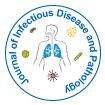The Role of the Human Microbiome in Fungal Disease Susceptibility
Received Date: Jan 01, 2025 / Published Date: Jan 31, 2025
Abstract
The human microbiome plays a crucial role in maintaining immune homeostasis and protecting against opportunistic fungal infections. Comprising diverse bacterial, viral, and fungal communities, the microbiome interacts dynamically with host immunity to regulate fungal colonization and prevent pathogenic overgrowth. Disruptions in microbiome composition, often due to antibiotic use, immunosuppression, or chronic disease, can create an environment conducive to fungal infections such as candidiasis, aspergillosis, and cryptococcosis. The gut, oral, and skin microbiomes are particularly influential in modulating fungal pathogenicity, with commensal bacteria such as Lactobacillus and Bifidobacterium playing key roles in suppressing fungal overgrowth. Recent research highlights the potential for microbiome-targeted therapies, including probiotics, prebiotics, and fecal microbiota transplantation, in restoring microbial balance and reducing fungal disease susceptibility. Understanding the complex interactions between the human microbiome and fungal pathogens is essential for developing novel antifungal strategies and improving patient outcomes, particularly in immunocompromised individuals.
Citation: Camano A (2025) The Role of the Human Microbiome in Fungal Disease Susceptibility. J Infect Pathol, 8: 283. Doi: 10.4172/jidp.1000283
Copyright: © 2025 Camano A. This is an open-access article distributed under the terms of the Creative Commons Attribution License, which permits unrestricted use, distribution, and reproduction in any medium, provided the original author and source are credited.
Select your language of interest to view the total content in your interested language
Share This Article
Recommended Journals
Open Access Journals
Article Tools
Article Usage
- Total views: 554
- [From(publication date): 0-0 - Nov 19, 2025]
- Breakdown by view type
- HTML page views: 427
- PDF downloads: 127
